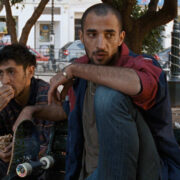Lana Banana, Candyman, Candyman: Being An Ally In American Horror

Michael Colbert is a writer based in Portland, Maine. He…
“It was always you, Lana.” We may as well hear Bloody Face say this to Lana Winters (Sarah Paulson) in the tail end of American Horror Story: Asylum. Asylum brings us through Briarcliff, a Massachusetts mental institution in the 1960s run by Sister Jude, a nun with a taste for sadism, and home to a Nazi doctor experimenting on patients in the basement – patients being treated for anything from nymphomania to schizophrenia. We enter Briarcliff with Lana Winters, an ambitious reporter looking for her big break and for Bloody Face, the serial killer she believes is locked up inside.
A show known for its reprisals of the horror canon, American Horror Story ensures its second season is no exception and evokes Bernard Rose’s 1992 film Candyman. Both the show and the film tell stories of women entering spaces that ensnare them in their quest for knowledge. In Rose’s film, graduate student Helen Lyle enters Chicago’s housing project Cabrini Green in pursuit of Candyman, an urban legend to whom the black community attributes their daily horrors.
Why bother comparing these two women and these two works? Falchuck and Murphy don’t give us any other choice. They underscore the final episodes of Asylum with “Helen’s Theme,” easily identifiable as Philip Glass’s work in Candyman.When Lana escapes the asylum, confronts Bloody Face, and advances to journalistic fame, we hear minimalistic, foreboding organs and choirs. In Candyman, this music plays over shots of Chicago, over highways that separate Helen’s world from Cabrini Green, white from black. In Asylum, this same music creates a bridge between the two women as Lana’s determination enables her to escape from Briarcliff and find acclaim in the world of journalism just as Helen seeks the same fame in academia. While music solidifies the apparent connection between two ambitious women, the familiar narrative surfaces in their entrance to gothic spaces, an entrance that entangles them in horror.
Dark Spaces
Urban legend says that if you say Candyman’s name five times in the mirror, he’ll come out and rip you from the groin up with his hook. Helen and her research partner Bernadette try this during a night of wine and brainstorming at Helen’s apartment. They seek an edge for their paper on urban legends that stodgy academics who stay away from Cabrini won’t find. To do this, they drive to the projects across the highways that bisect the city, separating black from white.
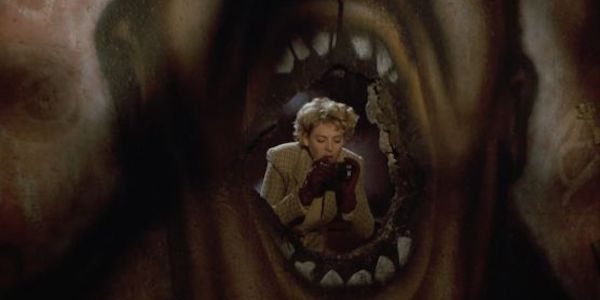
During her visits to Cabrini Green, Helen posits herself as an empathetic ally to people she meets, understanding of their trouble and different from the police who they suspect Helen and Bernadette to be. Helen’s access to Cabrini Green is predicated on this attempted empathy. Instead of challenging Helen’s shallow notion of allyship and understanding, Candyman rewards her for it as the people she meets inside, like young mother Annemarie, come to like and trust her. People open their doors to her and welcome her into their lives.
Helen’s intrusion is best encapsulated in the shot of her climbing through Candyman’s mouth, painted in graffiti on the wall. She climbs through on hands and knees and, maybe in a moment of dramatic irony, we see that she’s quite literally gotten herself into Candyman before she realizes it herself. Perhaps more alarming is how she forces her way into Cabrini Green in this shot. She births herself from him and comes into a world that isn’t hers. Yet instead of a forceful delivery like in Alien, she stumbles into this world driven by her desire to know more.
Lana, on the other hand, enters Briarcliff, a mental institution in Massachusetts, perceiving corruption and in search of the serial killer Bloody Face. Though she first visits under the pretense of writing a story about the asylum’s bakery, she revisits at night, entering through a network of subterranean tunnels in search of Bloody Face. Lana moves through labyrinthine space and becomes consumed by it without escape. Sister Jude, who runs the facility, captures Lana and blackmails her partner into committing her for treatment for her homosexuality. Jude, an equally strong woman who talks about her Vatican aspirations with the monsignor, cannot afford for Lana to defame the asylum. Lana’s sexuality provides her with all she needs for blackmail and a course of treatment.
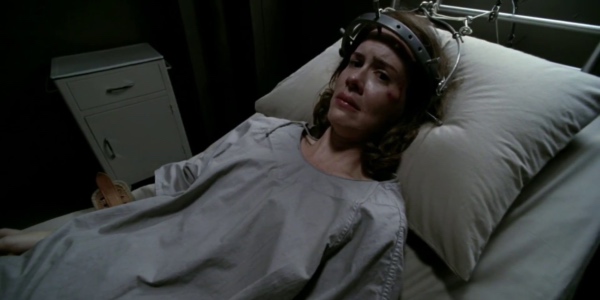
Once Lana and Helen enter these dark, dank spaces, neither woman is able to disentangle herself from the horror inside. Yet, when Helen visits Cabrini Green, she’s able to move across a divided Chicago back into white spaces. Though she becomes ensnared with Candyman as he pursues her, she exhibits freedom of movement. Lana, on the other hand, is trapped inside Briarcliff because her identity doesn’t afford her the same privilege.
Monstrous Summonings
Where Helen’s narrative further differs from Lana’s is the summoning of Candyman. Candyman is an urban legend, spoken about at night. Somebody who your friend’s cousin’s boyfriend’s roommate was slashed by. Helen and Bernadette try this to disprove the horror that Cabrini Green attributes to him. In calling forth Candyman, Helen commands mastery over – and expresses her doubt of – a narrative belonging to a black community. Though she believes herself to be an ally in visiting, she appropriates their legend and their suffering so that she can find an edge for her study and academic success. Helen views herself as different from the male academics who surround her, but she doesn’t seem to recognize the whiteness around her – in fact, someone at Cabrini Green even lumps her colleague Bernadette, herself black, in with all the other white people who come by asking questions.
Though Lana enters Briarcliff in pursuit of Bloody Face, she ends up meeting him as a circumstance of her already being trapped. Dr. Thredson, a psychiatrist in Briarcliff who we later discover is the killer, claims he can help cure her of her homosexuality in order to free her. He uses inhumane conversion tactics and, once he smuggles her out of the facility, rapes her in the basement of his home. Lana learns that Dr. Thredson is Bloody Face once he’s involved himself with her because of a part of her identity beyond her control, part of her identity that got her committed to Briarcliff in the first place.
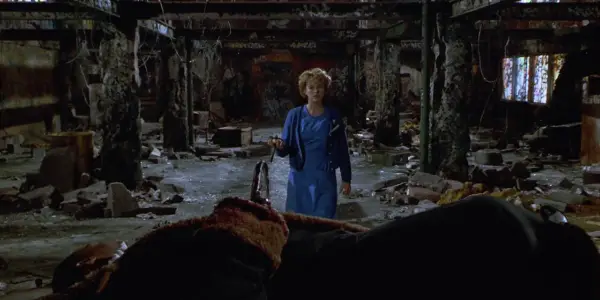
While Lana’s entanglement with Bloodyface results from her identity, Helen’s with Candyman begins with her white privilege, and here we see her becoming more problematic. As a white woman and academic, she can call up Candyman from the comfort of her apartment. Lana becomes entangled with Bloody Face once inside of Briarcliff because of her sexuality. Though she inserts herself into Briarcliff also in search of knowledge and an article that will boost her career, the justification of her internment finds root in her sexuality, not something she decided upon in order to demonstrate her mastery over a popular narrative like Helen does.
What Do They Say?
Candyman is criticized for its depiction of race, and it falls apart in its fantasy narratives. Daniel, the man behind the myth, was originally a skilled painter and free black man. He fell in love with a white man’s daughter while painting her and was slathered in honeycomb and stung to death by bees for revenge. Inside Cabrini Green are murals of him and his lover, a woman who looks just like Helen. Candyman’s pursuit of Helen amounts to a fantasy: she is the forbidden fruit he must have. In rescuing an infant in a fire from Candyman, she becomes a savior to the black community, and they all attend her funeral en masse. They throw Candyman’s hook onto her grave and give her his power, finalizing her whitewashing of his narrative.
Instead of critiquing Helen for her intrusion into Cabrini Green, the film lionizes her for it. What makes the ending sourer is how the people of Cabrini are the ones to do it. In the end, Helen moves from the fantasy narrative with Candyman, through a savior complex, to the space of urban legend, taking over the role of Candyman in the community and preying on her white husband in the end when he summons her. The film’s ending has us believe that the people of Cabrini want Helen to be their hero. While this may mean that the horrors of Candyman have left their community, Helen takes that power for herself and is willfully given it by them reeks of appropriation.
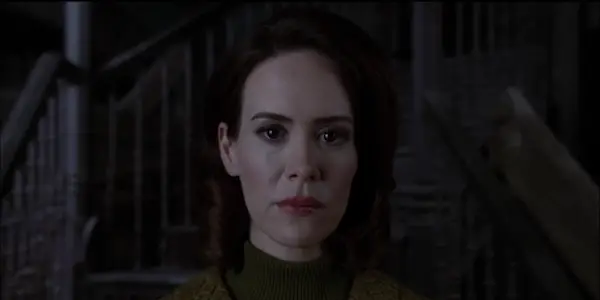
By the end of Candyman, the depiction of Helen becomes evidently problematic. In Lana’s parallel narrative with Bloodyface, she may seem more nuanced. But she gets lost in that nuance, too. Lana becomes a figure of horror in Asylum’s final episodes in how she skews the truth for an angle in her journalism. In an exposé of the church, her writing causes Monsignor Howard to commit suicide. She’s brutish to an intern at her book signing, and at a reading of her book about her struggle with Bloody Face, the ghosts of those who died in her struggle appear to call her out for her lies. Though Lana projects herself to fame, something about it doesn’t quite seem right.
In the chilling final scene of the season, after Lana gives an interview about her life and the mistakes she’s made in her career and subsequently murders her son, the child of Bloody Face, we’re returned to Briarcliff in 1964 and watch Lana’s initial confrontation with Sister Jude. Lana and Jude refer to ambition as a “sin” (Lana) and “dangerous” (Jude). The shots and reverse shots of them speaking use canted framing and create unease. Sister Jude tells Lana in closing, “Just remember if you look in the face of evil, evil’s going to look right back at you.” The camera cuts between close-ups of Sister Jude and Lana, zooming in with the effect of a vertigo shot. Here Jude judges, and the cut implies that Lana is the figure of evil.
Through cutting to Lana in this shot, Murphy and Falchuck take up where Rose never reaches. The audience of Candyman is made to problematize Helen’s interactions with race whereas with Lana, others within the show itself are in on it. While questions remain as to what exactly makes her the monster, Murphy and Falchuck engage with Lana as a problematic character. Rose, on the other hand, just creates one in Helen.
Lana becomes a figure of horror for her unfettered ambition, but her story differs from Helen’s in that she appropriates her own narrative instead of one not belonging to her. Asylum raises questions about the narratives of survivors and, like Candyman, falls apart in how it considers them. Today women’s voices are questioned and silenced. Lana emerges as someone who can tell her story, get the attention of others, and empower women in turn. Several episodes of the show detail Lana’s attempts to escape Briarcliff and the horrors that she faces as a result. Lana makes a life and career for herself after surviving assault and horrific treatment at Briarcliff. Yet, in the end, we’re made to see her as the ultimate figure of evil for her opportunism and ambition: she becomes the show’s final girl, and for that she’s the site of horror. Lana is damned for using her own narrative while Helen is lauded for appropriating another’s. We have to ask if Asylum wants us to believe that her acts of violence or female ambition are monstrous.
Evoking Candyman in this season, American Horror Story dredges up misplaced allyship and the appropriation of another’s culture and story. Though Lana’s version of this narrative is much more effectual in exploring sexuality and gender than Helen’s is with exploring race, in the end we’re still left with a big “huh”. Helen is the monster who people call from their mirrors, a figure of fear among teens at a sleepover. Lana – Asylum leads us to believe – is to be feared out in our world. She’s a woman moving and shaking, and we better hide when she comes for us.
Does content like this matter to you?
Become a Member and support film journalism. Unlock access to all of Film Inquiry`s great articles. Join a community of like-minded readers who are passionate about cinema - get access to our private members Network, give back to independent filmmakers, and more.
Michael Colbert is a writer based in Portland, Maine. He loves horror film (his favorites are Candyman and Rosemary's Baby), and he’s a coffee addict (his favorites are Costa Rican and Ethiopian). His work has appeared in Avidly, Maine the Way, and Germinal.


